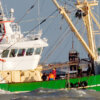Compliance monitoring is used to ensure that all legally or contractually stipulated restrictions are being met during the dredging process. This is the primary objective in planning a compliance monitoring programme.
Restrictions
Restrictions can vary markedly from one project to another depending on the prevailing human and ecological conditions at the dredging site. Restrictions may be either:
- physical (for example, dredging depth, location or transport mode, limitation on turbidity or sedimentation rate at a vulnerable site nearby),
- seasonally related (special restrictions during breeding or migration seasons of fauna) or
- quality oriented.
Given the costs of an extended compliance monitoring campaign, as well as the costs of implementation of potential mitigation measures, ensuring that a project’s environmental restrictions are formulated accurately is critical. Adding to the complexity of accuracy, one should keep in mind that most environmental parameters vary somewhat randomly.
Thresholds
Therefore, clarity and consistency in defining the thresholds which should not be exceeded during a predefined section of the execution period is highly recommended. Thresholds can be defined as the breaking points in an environment. At a threshold there is an abrupt change in the quality of the environment or ecosystem.
Different thresholds may have to be defined with different allowable percentages by which these thresholds may be surpassed.
To prevent later discussions about the accuracy or “the manipulation” of monitoring results, the environmental monitoring requirements must be clearly formulated defining the locations, frequency and duration of the monitoring.
















